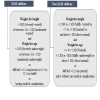Sociocultural Determinants of Nutritional Status Among Children Under Five Years of Age: An Ethnographic Study From Gujarat
- PMID: 36046281
- PMCID: PMC9418619
- DOI: 10.7759/cureus.27377
Sociocultural Determinants of Nutritional Status Among Children Under Five Years of Age: An Ethnographic Study From Gujarat
Abstract
Background The magnitude of child malnutrition, including severe child malnutrition, is high in India, and Gujarat has a higher prevalence of child malnutrition. Prior studies have employed anthropometric measures to identify the prevalence and associated factors of children's undernutrition. The present study explored community-level determinants of malnutrition among malnourished and well-nourished children in Devbhumi Dwarka district of Gujarat State, India. Methods A qualitative research employing focused ethnographic methodologies was used. In-depth observations of 60 families in a home food environment were carried out. Each child was observed at their respective homes for three consecutive days. Data were analyzed using thematic analysis techniques. Results The study revealed that lack of knowledge on malnutrition, inadequate feeding practices, poor socioeconomic status, insufficient hygiene and sanitation practices, lack of food variety, use of health facilities, and birth complications were the major community-based determinants of malnutrition. Conclusion The study identified community-level determinants of malnutrition among children under five years in the Devbhumi Dwarka district. To tackle the immediate and underlying causes of malnutrition, interventions are urgently needed to create community awareness about malnutrition as a disease and optimal infant and young child feeding (IYCF) practices using behavior change communication strategies.
Keywords: devbhumi dwarka; ethnography; gujarat; severe acute malnutrition (sam); social and community determinants.
Copyright © 2022, Umallawala et al.
Conflict of interest statement
The authors have declared that no competing interests exist.
Figures
Similar articles
-
Prime Minister's Overarching Scheme for Holistic Nutrition (POSHAN) on Wheels as a Drive Towards Combating Malnutrition Among Children in Coastal Gujarat.Cureus. 2022 Oct 10;14(10):e30137. doi: 10.7759/cureus.30137. eCollection 2022 Oct. Cureus. 2022. PMID: 36381854 Free PMC article.
-
Nutritional Status of Children Under Two Years of Age in the Devbhumi Dwarka District, Gujarat: A Descriptive Cross-Sectional Study.Cureus. 2022 Jul 29;14(7):e27445. doi: 10.7759/cureus.27445. eCollection 2022 Jul. Cureus. 2022. PMID: 36060336 Free PMC article.
-
Malnutrition in Devbhumi Dwarka: A Situation Analysis.Cureus. 2022 Aug 14;14(8):e27990. doi: 10.7759/cureus.27990. eCollection 2022 Aug. Cureus. 2022. PMID: 36120252 Free PMC article.
-
Triple Burden of Malnutrition among Children in India: Current Scenario and the Way Forward.Indian J Pediatr. 2023 Dec;90(Suppl 1):95-103. doi: 10.1007/s12098-023-04739-x. Epub 2023 Jul 28. Indian J Pediatr. 2023. PMID: 37505406 Review.
-
Nutritional Indicators for Gujarat, Its Determinants and Recommendations: A Comparative Study of National Family Health Survey-4 and National Family Health Survey-5.Cureus. 2023 May 18;15(5):e39175. doi: 10.7759/cureus.39175. eCollection 2023 May. Cureus. 2023. PMID: 37378193 Free PMC article. Review.
Cited by
-
A Review of Infant and Young Child Feeding Practices and Their Challenges in India.Cureus. 2024 Aug 9;16(8):e66499. doi: 10.7759/cureus.66499. eCollection 2024 Aug. Cureus. 2024. PMID: 39246879 Free PMC article. Review.
-
Association between maternal decision-making and mental health and the nutritional status of children under 6 years of age in sub-urban Nigeria.BMC Public Health. 2023 Jun 15;23(1):1159. doi: 10.1186/s12889-023-16055-2. BMC Public Health. 2023. PMID: 37322502 Free PMC article.
References
-
- World Health Organization: Malnutrition. https://www.who.int/news-room/fact-sheets/detail/malnutrition 2021
-
- National Family Health Survey, India. http://rchiips.org/nfhs/factsheet_nfhs-4.shtml 2022
-
- OCHA: 2020 global nutrition report: action on equity to end malnutrition. Micha R, Mannar V, Afshin A, et al. https://globalnutritionreport.org/reports/2020-global-nutrition-report/ 2020
-
- UNICEF: The state of the world’s children: Children, food and nutrition. https://data.unicef.org/resources/state-of-the-worlds-children-2019/ 2019
-
- Determinants of child malnutrition in Nepal: a case analysis from Dhanusha, central Terai of Nepal. Sah N. https://catalog.ihsn.org/index.php/citations/6569 IHSN. 2005
LinkOut - more resources
Full Text Sources

